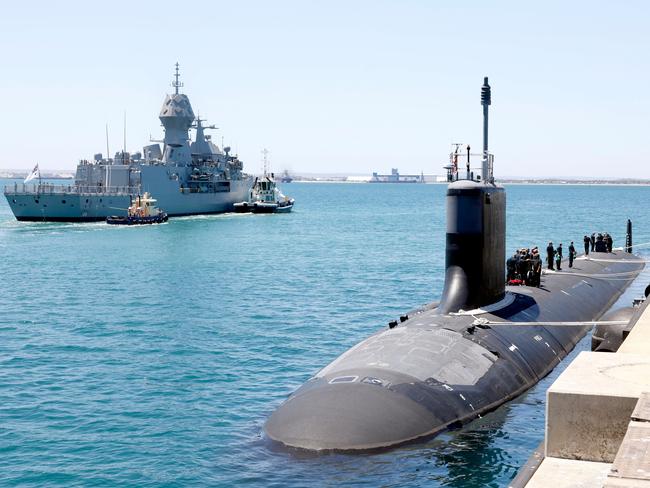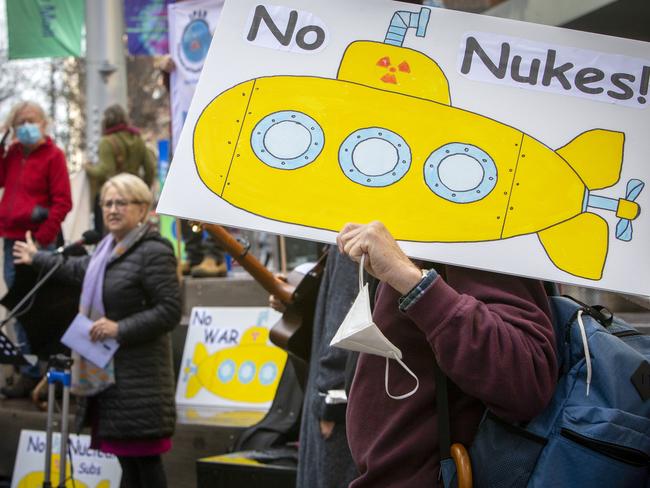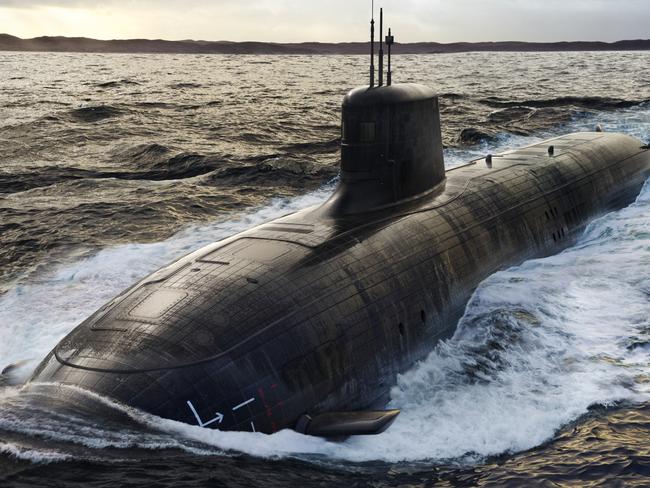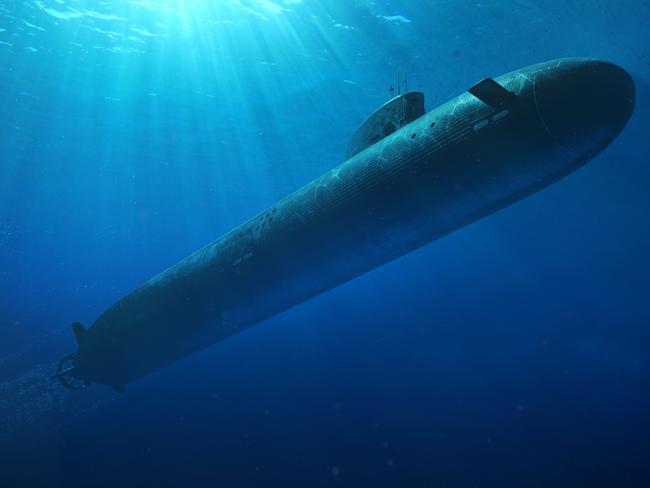Why Australia’s AUKUS nuclear subs agreement is such a big deal
The Pentagon has approved the sale of up to 220 Tomahawk cruise missiles to Australia as part of the AUKUS pact. See why it’s significant.
National
Don't miss out on the headlines from National. Followed categories will be added to My News.
The US Defence Department has approved the potential sale of up to 220 Tomahawk cruise missiles to Australia for the Virginia class submarines acquired under the AUKUS deal.
It comes just days after the AUKUS deal was finalised, which includes Australia purchasing between three and five US-Virginia class submarines from America while building British designed submarines domestically.
Here’s what you need to know about the missile and subs deal.
What is significant about the missiles?
The trilateral security pact between Australia, the UK and the US announced on September 15, 2021 allows for Australia to acquire nuclear-powered, but not nuclear-armed, submarines.
On Thursday, the Pentagon’s Defence Security Cooperation Agency notified US Congress that it had approved the sale of 220 Tomahawk missiles, although negotiations have not yet finished.
The missiles, which are valued at $US895 million ($A1.35 billion), have a range of 1500km.
Defence Industry Minister Pat Conroy told ABC TV that the missiles would “promote peace and stability” because they would put “question marks in any adversary’s mind”.
He also suggested the missiles could “potentially” be available to Australia before the first of the AUKUS submarines comes online in 2033.

Opposition Defence spokesperson Simon Birmingham told Sky News the purchase of the missiles had bipartisan support.
“We made clear that it was important for Australia to be securing more long range strike capability to be able to project power further in defence of Australia,” he said.
While the AUKUS deal has been criticised by some commentators, most notably former Labor Prime Minister Paul Keating, it is widely believed that the pact will provide Australia a significant uplift to its national security defences with the submarine alone a critical deterrent tool to counter China’s military expansionist ambitions in the Indo-Pacific.
The deal is being pitched as the most significant capability upgrade to our nation’s defences (and industrial challenges) since what we had to do for World War Two. It will be expensive too, up to $A368 billion over the course of the 30-year program starting this year.
Why are we getting the nuclear subs now?
Australia’s current fleet of Collins class submarines are in the process of getting an end of life extension upgrade but the diesel-electric boats are simply too old to compete or act as a deterrent having been built largely during the 1990s.
They were due to be retired in 2026 at which time Australia was to have a French designed Attack class submarine but that costly program, which began in 2007, faced delays and huge hurdles, due in no small part to the then Australian government’s contractual requirement they be largely built in Australia.
They too were also to be noisily vulnerable diesel-electric boats. The expected cost blew out to $90 billion, almost twice the budget, with expectations that would reach $216 billion by 2055.
In short, it was going to be outdated, too noisy and not meet Australia’s rapidly evolving security needs and was cancelled when the government announced the AUKUS pact.

How will the subs deal work?
Australia will have a fleet of eight nuclear-powered submarines by about 2053 under a plan to purchase ready-made vessels from the US before building a new hybrid SSM-AUKUS submarine, building one on average every three years.
By 2027 up to four US and one UK submarines to rotate through HMAS Stirling in Western Australia to familiarise RAN submariners with Australia to receive its own first US-built Virginia Class submarine from the US in 2033, second delivery in 2036 and third in 2039.
In 2042 Australia’s first SSN-AUKUS submarine will be built domestically, with an option to purchase up to two more Virginia Class submarines if there are delays with the new design. Components of the new AUKUS class submarine, largely built in South Australia and WA, will also feed the supply chain of development to the US and UK.
What will make this subs deal any better?
Under this deal, Australia will receive in the first instance five off-the-shelf already-in-service Virginia-class submarines from the US in the 2030s and then help build here in Australia a new class of boat being jointly developed from the British designed Astute class.
The technology behind the nuclear-powered submarine has long been considered the holy grail of tech and was shared only once, by the United States to the UK in the 1950s.
What makes it so special is these submarines are powered by a nuclear reactor effectively the size of a shoebox and once sealed can last untouched virtually forever.
Limited electric energy batteries make for slow noisy boats that have to surface every few days (and effectively become a target).
The US-made Virginia class and British made Astute class do not and can remain at high speed and below water forever, or at least until it has to surface to restock food.
This means they have significant operational capabilities far advanced to anything anyone else has including the Chinese.
The new submarine development program will be overseen also by a multi-agency body to avoid single agency delays.

But the Greens have branded these submarines as “Floating Chernobyls”?
Well for a start they are designed to exist underwater so not float about but no it is a ridiculous analogy designed to create fear and opposition to the project.
Unlike the days of Russian built infrastructure and technology including radiation leaks on their submarines, the US has operated nuclear-powered submarines without incident since the first one USS Nautilus launched in 1954 and the technology has advanced considerably since then.
What will be needed to support Australia’s nuclear-powered sub fleet?
Workers and infrastructure. Prime Minister Anthony Albanese has already forecast 20,000 Australian jobs with 8500 of those being scientists, engineers, electricians, metal fitters and welders.
Shipyards in Adelaide and Perth will be the big winners with the bulk of the work and jobs and infrastructure construction being there.
But then there has to be work on their new submarine base expected to be in NSW, construction of which would also have to start sooner rather than later.
The shortage of skilled labour has already been identified as an issue not to mention the shortage already of submariners.
Having a new base near the more populous east coast will alleviate some of the recruitment challenges Perth has had at the current HMAS Stirling submarine pen.
The navy currently has 900 submariners but needs 200 more immediately to deploy to the US and UK for training ahead of the first boat’s arrival to our shores.

What will the new model submarine look like?
A new model submarine dubbed SSN-AUKUS will be developed with Australia, the US and the United Kingdom each making components to put together like the world’s most complex Lego kit.
The design will be based on the British made nuclear-powered Astute-class submarine to incorporate technology and materials from all three countries, notably a US combat system.
This is important as the Royal Australian Navy (RAN) already uses American combat tech and the delivery of the US-made Virginia-class, as a stop gap before the SSN-AUKUS rolls out, will only deepen the RAN’s experience ahead of the AUKUS class development. It is expected to have a vertical launch system for land attack missiles, most likely Tomahawks, as well as multiple torpedo tubes.
The DNA of the Virginia and the new class will be similar including and the capability shift from one to the other has been described by Defence as “low risk” due to the degree of systems commonality.

When will the building of the subs begin?
Australia and the UK will begin domestic shipyard building, in Australia’s case primarily at Osborne in South Australia, before the end of this decade with the delivery of an Australian built boat expected in the early 2040s.
The UK is already developing theirs and expect to have one in the water in the late 2030s.
The fact a prototype will already exist before Australia embarks on its development is also critical given Defence’s poor track record on high end military new builds.
Defence Industry Minister Pat Conroy said Defence had “learnt its lesson” and Australia was not building a first-of-class.
While the Virginia class requires a submariner compliment of 132 personnel, the SSN AUKUS will be smaller with 100-110. Australia’s current Collins class has a compliment of just 60 submariners.
Defence Minister Richard Marles described the submarine program overall as the biggest leap in ADF capability “in our history” and how production lines here and in the UK worked in tandem here and overseas was still being worked out.
“You will see certain capabilities which have to be done on both production lines the most obvious being the final assembly of the submarine but you are also going to see certain parts of the submarine built in one country for the run in both countries and the US as well.
“The nuclear reactor will be built in the UK but you will see Australian companies building elements for both countries and these are going to be quite connected production lines. That’s what we call the build strategy and the timeline for that is in the next 18 months.”
More Coverage
Originally published as Why Australia’s AUKUS nuclear subs agreement is such a big deal




